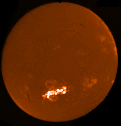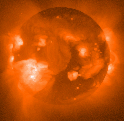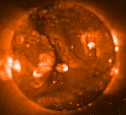
Sample Solar Data
Greenbelt, MD 20771, USA
 |
Sample Solar Data |
| NASA Goddard Space Flight Center Greenbelt, MD 20771, USA |

This image of the Sun in the H-alpha spectral line of hydrogen emission (6563Å), a line which is often used in the study of solar flares because flares typically heat their sites enough to emit this red light conspicuously. The bright area is a solar flare, which extended over 300,000 km (200,000 miles) across the surface of the Sun, and which was an extremely copious source of high-energy protons (10-100 MeV). The flare lasted for over an hour and produced enough high-energy proton radiation to kill an astronaut standing on the Moon in a space suit. Flares with this radiation output occur rarely -- only a handfull per decade -- at unpredictable time. If astronauts had been on the Moon, they would have needed a warning to enter a protective structure or cover themselves with lunar soil for protection. A Space Shuttle flight was in progress during this flare, and a space walk was not scheduled, but would have been harmful if necessary; the hull of the Shuttle was sufficiently shielding to the crew, but they noticed irritating flashes of light as a few of the most energetic protons penetrated the hull and their eyes.
This image was made at Holloman Air Force base and provided at 512 x 512 pixel resolution. It was displayed on an IBM PC compatible using software written by Dr. David Batchelor (SPDF), and then encoded as a GIF. Such images are available from the NOAA Space Environment Lab (SEL), and are known as SELSIS images (SIS - Solar Image System). The PC software is available from D. Batchelor. NOAA is the source for the SELSIS image data files.

This image of the Sun in the wavelength band 3- 45Å, recorded with the Soft X-ray Telescope aboard the Japanese/USA spacecraft Yohkoh (the Japanese word for sunlight). The globe of the Sun can be seen as dark because it is not hot enough to emit X-rays. The bright areas surrounding the dark globe are hot clouds of gas (1-2 million K) in the Sun's corona, which glow in X-rays. The appearance of bundles or skeins of threads is due to the magnetic field of the Sun, which traps and constrains the forms of the clouds, as well as playing a still poorly-understood role in heating the clouds to such a higher temperature than the Sun's surface (5800 K). Scale: the Sun's diameter is approximately 1,400,000 km (840,000 miles). ISAS is the Japanese space agency. Yohkoh data become publicly available two years after acquisition, through the SDAC or NSSDC.

This image of the Sun in the wavelength band 2-32 and 44-54Å, recorded with X-ray Spectrographic Telescope aboard the Skylab spacestation on 1973 June 19 at 06:19 UTC. The globe of the Sun can be seen as dark because it is not hot enough to emit X-rays. The bright areas surrounding the dark globe are hot clouds of gas (1-2 million K) in the Sun's corona, which glow in X-rays. The appearance of bundles or skeins of threads is due to the magnetic field of the Sun, which traps and constrains the forms of the clouds, as well as playing a still poorly-understood role in heating the clouds to such a higher temperature than the Sun's surface (5,800 K). Scale: the Sun's diameter is approximately 1,400,000 km (840,000 mi.). This image has been processed to enhance the sharpness of its features, using the unsharp masking process, which suppressed features larger than 73,000 km in size. On the left edge (or east limb) of the Sun, a large magnetized arch of gas is visible; this feature lasted several hours.
Data files encoding 1,471 images of this kind may be obtained from NSSDC. Contact NSSDC for details. Software for processing and displaying the images on IBM PC compatibles and other platforms was written by Dr. David Batchelor and is also available from NSSDC.
Additional solar images are available on the NSSDC Photo Gallery Solar page.
This information was originally provided by Dr. David A. Batchelor.